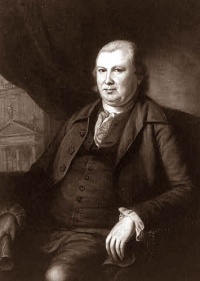 Robert Morris was born in Liverpool, England in 1734, the son of ironmonger Robert Morris, Sr. When the senior Morris emigrated to the colonies, he settled in Maryland and became a tobacco agent.
Robert Morris was born in Liverpool, England in 1734, the son of ironmonger Robert Morris, Sr. When the senior Morris emigrated to the colonies, he settled in Maryland and became a tobacco agent.Robert joined his father in Maryland in 1747 and was an apprentice in the Philadelphia mercantile house of Charles Willing. Here he quickly exhibited exceptional talent for commercial pursuits. In 1757 he became a partner in the firm of Willing and Morris which became one of the best known trading companies in the colonies, developing mercantile ties in Great Britain, Portugal, Spain and the West Indies. By 1773 the firm owned at least ten ships and chartered others as the need arose.
Even before the American Revolution, Morris was active in the 1765 fight against the Stamp Act and was a signer of the Non-Importation Agreement. In 1775 he served both as vice-president of Pennsylvania’s Committee of Safety, particularly charged with serving as banker and procurer of arms. That same year he was elected to the provincial assembly and as a Pennsylvania delegate to the Continental Congress, where he was vitally involved in committees relating to trade, war, the navy and foreign affairs.
In 1776 he signed the Declaration of Independence and began his role as the emerging nation’s chief financial agent, on numerous occasions using his savvy as merchant and financier as well as his personal credit to keep supplies coming and the public credit sound in a complicated and difficult situation. On several occasions he personally rescued the Revolution from ruin. As the Revolution progressed, Morris was reelected to the Pennsylvania assembly, attended the second Continental Congress and signed the Articles of Confederation.
With strong business acumen and as a key financial player in the political arena Morris, suggested he be allowed to set up a Bank of England style central bank in America in 1781.
The impoverished American Government was desperate for money. The $400,000 Morris proposed to deposit and then to allow him to loan out many times that through fractional reserve banking, looked really attractive idea to the government. It worked for England, didn’t it?
Already spending the money they would be loaned, no one made a fuss when Robert Morris couldn’t raise the deposit, and instead suggested he might use some gold, which had been loaned to America from France.
Once in, he simply used fractional reserve banking, and with the banks growing fortune he loaned to himself, and his friends the money to buy up all the remaining shares. The bank then began to loan out money multiplied by this new amount to eager politicians, who were probably too drunk with the new ‘power cash’ to notice or care how it was done.
The scam lasted five years until in 1785, with the value of American money dropping like a lead balloon. The banks charter didn’t get renewed.
The shareholder’s walking off with the interest did not go unnoticed by the governor.
“The rich will strive to establish their dominion and enslave the rest. They always did. They always will… They will have the same effect here as elsewhere, if we do not, by (the power of) government, keep them in their proper spheres.”
Governor Morris – THE CONSTITUTIONAL CONVENTION OF 1787, 7/2
Still, did America learn?
Enter in the First Bank of the United States.
